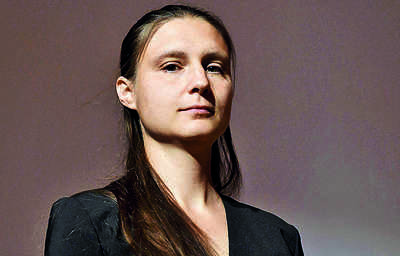- News
- World News
- Europe News
- Ukrainian 2nd woman to win Fields medal, 'Nobel prize' for maths
Trending
This story is from July 6, 2022
Ukrainian 2nd woman to win Fields medal, 'Nobel prize' for maths
Ukraine's Maryna Viazovska paid tribute to those suffering in her war-torn country on Tuesday as she became the second woman to be awarded the Fields medal, known as the Nobel prize for mathematics.

HELSINKI: Ukraine's Maryna Viazovska paid tribute to those suffering in her war-torn country on Tuesday as she became the second woman to be awarded the Fields medal, known as the Nobel prize for mathematics. Viazovska, a 37-year-old Kyiv-born math professor, received the prestigious award alongside three other winners at a ceremony in Helsinki. "My life changed forever" when Moscow invaded Ukraine in February, she said in a video displayed at the ceremony, adding that her sisters had been evacuated from Kyiv."Right now Ukrainians are really paying highest price for our beliefs and our freedom," she said.
The International Congress of Mathematicians was initially scheduled to be held in Russian city Saint Petersburg - and opened by President Putin. Hundreds of mathematicians signed an open letter protesting the choice, and after Moscow invaded Ukraine the event was moved to the Finnish capital. The other Fields winners were France's Hugo Duminil-Copin of the University of Geneva, Britain's James Maynard of Oxford University and June Huh of Princeton in the US. The medal, along with $11,600, is awarded every four years to between two to four candidates under the age of 40 for "outstanding mathematical achievement". Of the 60 mathematicians who won Fields Medals before this year, 59 were men. The only previous female laureate in the prize's more than 80-year history was Iranian mathematician Maryam Mirzakhani, who won it in 2014. "I feel sad that I'm only the second woman," Viazovska said. "I hope it will change in the future."
In a decision made before the war in Ukraine began, Viazovska was awarded for her work in sphere packing - a problem first posed by German astronomer and mathematician Johannes Kepler nearly 400 years ago. In what is called the Kepler conjecture, he proposed that the most compact way to pack spheres was in a pyramid, like oranges at a supermarket. But it was such a complex problem that it was not considered proved correct until 1998 via intense computer number-crunching. Then in 2016, Viazovska solved the problem in the eighth dimension, using what is called an E8 lattice.
The International Congress of Mathematicians was initially scheduled to be held in Russian city Saint Petersburg - and opened by President Putin. Hundreds of mathematicians signed an open letter protesting the choice, and after Moscow invaded Ukraine the event was moved to the Finnish capital. The other Fields winners were France's Hugo Duminil-Copin of the University of Geneva, Britain's James Maynard of Oxford University and June Huh of Princeton in the US. The medal, along with $11,600, is awarded every four years to between two to four candidates under the age of 40 for "outstanding mathematical achievement". Of the 60 mathematicians who won Fields Medals before this year, 59 were men. The only previous female laureate in the prize's more than 80-year history was Iranian mathematician Maryam Mirzakhani, who won it in 2014. "I feel sad that I'm only the second woman," Viazovska said. "I hope it will change in the future."
In a decision made before the war in Ukraine began, Viazovska was awarded for her work in sphere packing - a problem first posed by German astronomer and mathematician Johannes Kepler nearly 400 years ago. In what is called the Kepler conjecture, he proposed that the most compact way to pack spheres was in a pyramid, like oranges at a supermarket. But it was such a complex problem that it was not considered proved correct until 1998 via intense computer number-crunching. Then in 2016, Viazovska solved the problem in the eighth dimension, using what is called an E8 lattice.
End of Article
FOLLOW US ON SOCIAL MEDIA










